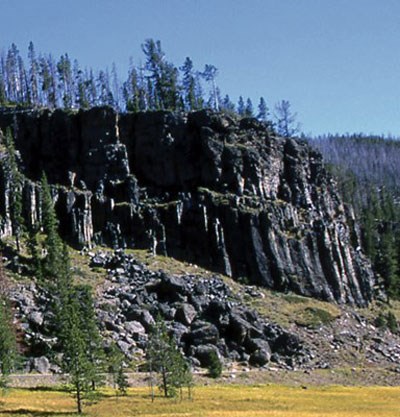Last updated: June 17, 2022
Article
Hopewell Culture Obsidian

NPS Photo
Written by Park Guide Sarah Hinkelman
Obsidian is a unique material. It is naturally forming glass (a type of igneous rock) that is only formed from the rapid cooling of lava, so it only occurs in places where there are volcanoes. You might be wondering, “What is obsidian doing in the Scioto River valley in Ohio? There are no volcanoes here!” This is a reasonable question. The nearest volcano is over 1,500 miles away in Yellowstone National Park in Wyoming. What was it about this material that motivated the people who participated in the Hopewell culture to obtain it and place it within their magnificent earthworks in Ohio? Well, even today obsidian continues to be valued for its properties and its connections to the earth, a similar connection was likely true for the people who lived in the Scioto Valley 2,000 years ago.
Obsidian is naturally occurring glass that is jet black in color but can also be brown, tan, or green. However, the obsidian found in the earthworks here in the Scioto River Valley seems to be only black in color. The obsidian artifacts found in Hopewell Culture National Historical Park came from Obsidian Cliff in Wyoming, inside Yellowstone National Park, and Bear Gulch in Idaho, just west of the National Park boundary. We know this from scientific studies on obsidian that compare the elements found in the obsidian in Ohio to different possible source sites in North America through techniques like x-ray fluorescence (XRF) which measures the chemicals in rocks, minerals, sediments, and liquids. All the matches from Ohio obsidian artifacts can be traced back to the Yellowstone region.

NPS Photo

NPS Photo
In the vast amount of land between Ohio and Wyoming there is hardly any presence of obsidian other than in Hopewell sites. This leads archeologists to believe that the material was not traded down-the-line but carried directly to the Scioto Valley. The material was likely brought to Ohio by ancient peoples either making quests to the source to experience the journey as a religious experience similar to a religious pilgrimage or vision quest; or was carried by those coming from faraway lands to participate in the ceremonial events occurring at the earthwork complexes in the Scioto River Valley. Either way, the journey from Yellowstone to Ohio was a life-changing event for those who completed it.
Obsidian is a strong material, yet it can be easily shaped by chipping away flakes in a process called knapping. The obsidian found within the earthworks in the Scioto River Valley was shaped into large, elaborate spear points. The largest obsidian spear, found in Hopewell Mound Group, is over 17 inches long and six inches wide. These spear points were not for hunting or everyday use—they were ceremonial. They were likely only displayed or used during religious events. Four out of five of the obsidian spear points at Mound City were found broken alongside other ritual artifacts and human remains. These spear points were broken intentionally, likely ritually destroyed before they were buried.
Archeologists believe that for the ancient people in the Scioto River Valley, obsidian was strongly connected to the spiritual world. The material is formed from volcanic activity deep in the earth that rises up to the surface and is retrieved from a place surrounded by natural wonders. The spiritual connection is still felt today. Visitors to Yellowstone National Park come to see the steam propel up to the sky from geysers, marvel at the rich colors of the pools surrounding the thermal features and take in the terraces and rock formations formed by the volcanic activity and the movement of glaciers. In this natural space we can feel a connection to the earth and the forces of nature that are larger than us. Obsidian was likely seen as an embodiment of these elements too for the people who brought it to the earthwork complexes here in the Scioto River Valley.
Even today obsidian is viewed as a very special material. Because of its rich color and shine, it is often found in jewelry and decorative elements as a semi-precious stone and is even used as mirrors. Obsidian’s glass-like texture makes it incredibly sharp and it has been used in the place of surgical scalpels. The cutting edge on obsidian is so sharp and thin it can cut between cells rather than tear through tissue like steel scalpels. Many people are familiar with this magnificent stone as obsidian appears in pop culture as Dragon Glass in the Game of Thrones and as a challenging and highly sought material that players collect on Minecraft.
